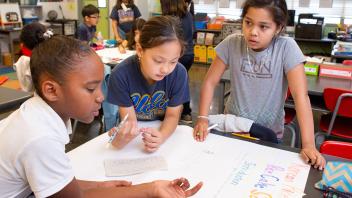Helping children expand their vocabulary is one of the best ways to ensure that they become successful readers and writers (Tabors, Snow, & Dickinson 2001). It is also an effective way to help children learn science concepts. To think through and explain why something might happen and why something might work, children need to have the words to express these thoughts.
Add science vocabulary words to a classroom word wall. Model the use of terms such as estimate, predict, atmosphere, and habitat in day-to-day conversation and encourage children to use the vocabulary themselves: “You’re right, Casey. The vinegar bubbled up when you added the baking soda — just as you predicted it would. What other mixtures would you like to investigate?” As children build their literacy skills, provide forms for recording observations so they can also grow in their inquiry skills and practice using scientific vocabulary. Language modeling and concept development (Pianta, LaParo, & Hamre 2008) can make a real difference in children’s learning.
- Model science-related vocabulary, using scientific terms as children interact with engaging materials and planned experiences.
- Encourage meaningful conversations and expand on what children say.
- Provide many opportunities for using science-related language and engaging in hands-on experiences that deepen children’s understanding of the words.
- Ask open-ended questions that promote predicting skills and teach problem-solving skills: “Now that we’ve frozen water into all these interesting shapes, which of them do you think will melt most quickly? Let’s write down our predictions. How can we find out if we’re right?” Let children make their own predictions, try things out, and note what works and why.
- Use words to describe our actions and the children’s actions: “I’ll pour this water into the cup of cornstarch as you stir. Let’s observe what happens as we try to pick up the interesting mixture we’ve just made. Is it more like a solid or a liquid?”
Copyright © 2009 by the National Association for the Education of Young Children. See Permissions and Reprints online at www.naeyc.org/yc/permissions.
